December, 2014 —
Since Christmas is not celebrated until January 5th in Spain, we decided to go to France to celebrate on the day we are accustomed to, December 25th. Bob figured we would be back in time to celebrate Christmas twice—ever the boy at heart. So off we went to Paris. Unfortunately for us, so did the rest of the world. It would seem that everyone woke up one morning in December and said “let’s go to Paris for the holidays”…
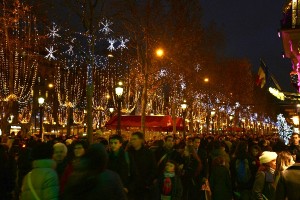 Battling the crowds, the cold and the rain, we strolled the Champs Élysées, the
Battling the crowds, the cold and the rain, we strolled the Champs Élysées, the 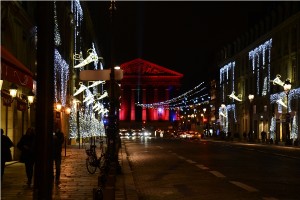 Seine, the Left Bank and everywhere we could walk within a day’s radius of our hotel. The Parisians are known for “strolling” and people watching, and the Champs Élysées was the place to be, albeit a human traffic jam every day. But all was good. As Americans, it takes a bit to downshift to that pace. Forced, we adopted to the local lifestyle of strolling, alternating with respites for coffee or wine depending on the hour of the day. C’est fantastique!
Seine, the Left Bank and everywhere we could walk within a day’s radius of our hotel. The Parisians are known for “strolling” and people watching, and the Champs Élysées was the place to be, albeit a human traffic jam every day. But all was good. As Americans, it takes a bit to downshift to that pace. Forced, we adopted to the local lifestyle of strolling, alternating with respites for coffee or wine depending on the hour of the day. C’est fantastique!
Paris being the “City of Lights” lived up to its expectation. The Champs Élysées was lit from one end to the other as was every other major street and pedestrian square. 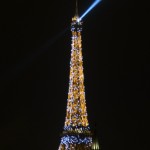 The city was ablaze in strings of Christmas lights, lighted decorations, lasers, LEDs, and spot lights. It was truly magical! From our hotel room we could see up and down the Champs Élysées with the Arc de Triomphe anchoring one end and the huge illuminated Ferris wheel the other. Across the Seine we could see the Eiffel Tower showered in its own light show every evening, on the hour, for five minutes.
The city was ablaze in strings of Christmas lights, lighted decorations, lasers, LEDs, and spot lights. It was truly magical! From our hotel room we could see up and down the Champs Élysées with the Arc de Triomphe anchoring one end and the huge illuminated Ferris wheel the other. Across the Seine we could see the Eiffel Tower showered in its own light show every evening, on the hour, for five minutes.
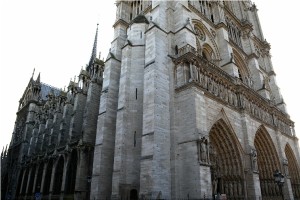 Sightseeing included visiting both the Louvre and Orsay museums.
Sightseeing included visiting both the Louvre and Orsay museums. 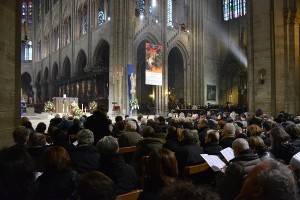 The Louvre was wonderful, despite the hour-plus line to enter, but a day barely scratched the surface. One would need a week to cover the entire museum. The Orsay, without the lines, was actually more enjoyable for us, with more contemporary (19th and 20th century) largely impressionistic works. One evening we enjoyed a spectacular Vivaldi Four Seasons concert at one of the cathedrals. Christmas morning we attended, not one, but two morning masses at Notre-Dame Cathedral. Surprisingly, it was the non-Catholic among us, Bob, that actually suggesting staying for the second one!
The Louvre was wonderful, despite the hour-plus line to enter, but a day barely scratched the surface. One would need a week to cover the entire museum. The Orsay, without the lines, was actually more enjoyable for us, with more contemporary (19th and 20th century) largely impressionistic works. One evening we enjoyed a spectacular Vivaldi Four Seasons concert at one of the cathedrals. Christmas morning we attended, not one, but two morning masses at Notre-Dame Cathedral. Surprisingly, it was the non-Catholic among us, Bob, that actually suggesting staying for the second one!
On Saturday we picked up a rental car and drove east to the champagne region. The champagne region of France, about 100 miles from Paris, would be all things champagne if not for its important history—the end of World War II. There were grape vines on trellis wires for as far as the eye could see. Each village was more picturesque than the next, and there were quaint stone homes and manicured grounds on every corner. We stayed at a lovely B&B that used to be a champagne winery. 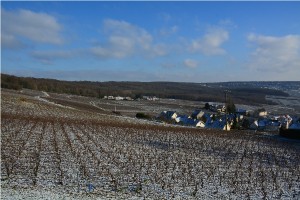 Today they are continuing the excavation of the old champagne storage tunnels for fossil study. During the Jurassic period this
Today they are continuing the excavation of the old champagne storage tunnels for fossil study. During the Jurassic period this 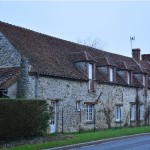 entire area was under the sea so it is a rich deposit of prehistoric shells and fossils. Another impressive underground experience was to tour the tunnels that are currently being used for champagne storage or aging. The network of tunnels is so vast it took 20 minutes on an electric train to tour just the perimeter.
entire area was under the sea so it is a rich deposit of prehistoric shells and fossils. Another impressive underground experience was to tour the tunnels that are currently being used for champagne storage or aging. The network of tunnels is so vast it took 20 minutes on an electric train to tour just the perimeter.
The city of Reims is the capital of this region, a city of about 160,000. The Cathedral at Reims is known as the Cathedral of Coronations, as over 30 French kings were coronated there; the last being Charles X in 1824. This Cathedral, of gothic architecture, was rebuilt in 1211 after a fire destroyed the original building. During World War I it was severely damaged by German bombs. Renovated, it was again damaged by the Germans in World War II. It is now owned by the French government and has been almost fully restored. It is also listed as a UNESCO site. 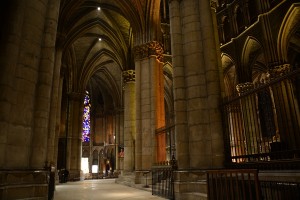 The style of the building is very plain in terms of color. The ornamentation is a combination of stained glass windows, stone arches, and the 2300 statues throughout the inside and outside of the cathedral.
The style of the building is very plain in terms of color. The ornamentation is a combination of stained glass windows, stone arches, and the 2300 statues throughout the inside and outside of the cathedral.
This year, throughout the Christmas season, a laser show set to music was projected onto the front of the Cathedral, every evening at 6 pm. The owner of the B&B where we were staying told us about it or we would have missed it. It was amazing. Click on the link below to view the video.
Reims was where General Eisenhower had a temporary headquarters for the last two years of the war. Reims also played an important role at the end of the war. On May 7, 1945, Nazi Germany surrendered, bringing World War II in Europe to an end. There, in the small schoolhouse that served as Eisenhower’s headquarters, the surrender documents were signed. Before the signing, four versions had been sent for approval to London, Paris and Moscow. They were required to be signed in English, French, Russian, and German. Hitler had already committed suicide. Admiral Doenitz assigned General Alfred Jodi, Chief of Staff of the Wehrmacht, to represent him. Eisenhower remained in an adjoining room and had Lt. General Walter Gedell Smith represent him. The terms of the Surrender were read aloud and interpreted, then signed. After the Germans had left the building, the remaining group all drank champagne out of mess kits to celebrate.
Historical note: the complete unconditional surrender, including all Soviet interests and the delayed ceasefire on the eastern front, would not be signed until the following day in Berlin. This allowed greater numbers of troops to surrender locally to the Western powers rather than to USSR.
Sara’s father was stationed in Dijon, France for the later part of the War, a tail gunner on a B26 bomber, flying many missions over Germany. On May 7, 1945 he was in Piccadilly Square in central London when the word came that the Treaty had been signed, a day he would never forget. London had been massively bombed by the Germans. Dad said the city instantly erupted into one huge party. It was such a joyous moment every man was kissing every woman in sight. The War in Europe was finally over!
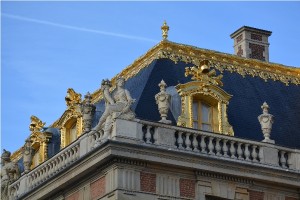 The last day in France we dialed back the time machine another 150 years to another significant period in Europe’s history—the French Revolution. We visited the Palace of Versailles which is the largest palace in the world, and quite possibly the most extravagant. It was certainly beautiful, but after seeing all the gold and excesses of that time it is no wonder there was a revolution.
The last day in France we dialed back the time machine another 150 years to another significant period in Europe’s history—the French Revolution. We visited the Palace of Versailles which is the largest palace in the world, and quite possibly the most extravagant. It was certainly beautiful, but after seeing all the gold and excesses of that time it is no wonder there was a revolution.

